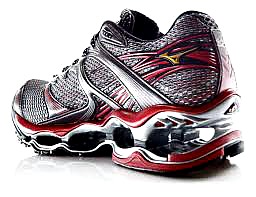In running, heel height correlates to injury whereby thick, cushioned heeled running shoes contribute to lower leg injury by altering the calf musculature as well as the mass-spring property of the Achilles tendon. Consistent with other studies, Mathews and Wooten also found that heeled footwear caused ankle joint stagnation.
 In other cases, researchers have observed that increased heel height resulted in greater muscular energy consumption and may trigger neuromuscular fatigue during running. Not to mention, heeled running shoes profoundly alters global posture and kinematics, causing running to be unusually challenging.
In other cases, researchers have observed that increased heel height resulted in greater muscular energy consumption and may trigger neuromuscular fatigue during running. Not to mention, heeled running shoes profoundly alters global posture and kinematics, causing running to be unusually challenging.
In support of these findings, Dattani and Dasgupta examined the physiological cost of wearing heeled footwear and found that heart rate increased as a function of heel height. Movement velocity also reduced with higher heeled footwear.
The evidence supports the idea that heeled footwear has too many functional consequences and should not be intended for clinical use. Likewise, the researchers garnered evidence that confirmed footwear with a heel height greater than 3 inches is health harming.
What’s the Solution?
In running, exceptional biomechanical ability correlates to heightened proprioception, an inherited feature of an efficiently functioning central nervous system. This is why habitual barefoot runners have superior mental capacities to generate less impact during running.
- Adding more and more cushioning under the foot interferes with the neuronal territories involved in movement control such as landing behavior. Therefore, less is more when it comes to protective footwear.
It is becoming more clear that runners underestimate the significance of wearing less protection on their feet to improve proprioception. Humans are gifted in running, and by wearing thin, zero-drop running shoes helps the brain rapidly identify the key information from the plantar surface to make optimal use of the lower extremity. This is why habitual barefoot and minimalist runners run more elegantly than conventional-shod runners. The truth is, forefoot running contributes more to injury prevention than under-heel protection does.
More From Run Forefoot:
- Running Shoes for Achilles Injury
- Heel Inserts Solve Nothing
- Forefoot Strike Wear Pattern
- Save BIG on Minimalist Running Shoes
- Full Minimalist Shoes for Forefoot Striking
- About the Author
References:
Dattani N and Dasgupta B. Physiological impact of heeled footwear.OIIRJ, 2015;5(2) 101-105.
Mathews DK, Wooten EP: Analysis of oxygen consumption of women while
walking in different style shoes. Arch of Phys Med Rehabilitation 1963 44: 569-571.

Bretta Riches
BSc Neurobiology; MSc Biomechanics candidate, ultra minimalist runner & founder of RunForefoot. I was a heel striker, always injured. I was inspired by the great Tirunesh Dibaba to try forefoot running. Now, I'm injury free. This is why I launched Run Forefoot, to advocate the health & performance benefits of forefoot running and to raise awareness on the dangers of heel striking, because the world needs to know.
Latest posts by Bretta Riches (see all)
- Can You Run In Barefoot Shoes? Yes, But DON’T Heel Strike! - 21/07/2024
- Why Cushioned Running Shoes Are Really Bad for Your Feet - 19/07/2024
- Do Cushioned Running Shoes Cause Injuries? - 17/07/2024

Leave a Reply